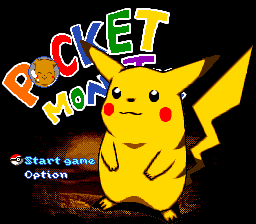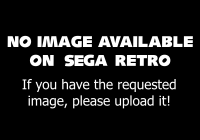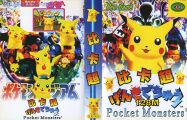Difference between revisions of "Pocket Monster"
From Sega Retro
m (series template) |
|||
| Line 14: | Line 14: | ||
| otherformats={{NonSega|SNES}} | | otherformats={{NonSega|SNES}} | ||
}} | }} | ||
| − | + | '''''{{PAGENAME}}''''', also known as '''''Bǐkǎchāo''''' (比卡超), is an unlicensed game for the [[Sega Mega Drive]] based on [[Nintendo]]'s ''Pokémon'' franchise. It is a platform game where the player controls Pikachu. | |
| − | The game's origins are unknown, however a port exists for the | + | The game's origins are unknown, however a port exists for the [[Super Nintendo Entertainment System]] and there is a sequel, ''[[Pocket Monster II]]''. Graphics are stolen from a number of games, including ''[[Tiny Toon Adventures: Buster's Hidden Treasure]]'', ''[[Mr. Nutz]]'', ''[[Quackshot Starring Donald Duck]]'', ''[[Magical Taruruto-kun]]'' and ''[[Monster World IV]]''. |
==Gameplay== | ==Gameplay== | ||
| + | ''Pocket Monster'' presents itself as a standard platformer across five side-scrolling levels, each level ending with a boss encounter. Pikachu is capable of moving left and right with the D-Pad and jumping with the {{C}} button. When Pikachu has collected at least 20 points of energy from batteries, he can perform an electrical attack with the {{A}} button, which takes out all on-screen enemies and does damage to bosses. Another way to defeat enemies is to jump on their heads, though defeated enemies will respawn when Pikachu moves away from their location and comes back. | ||
| + | |||
| + | Pikachu's health is represented by a two-digit number below the lives counter with a maximum value of 99, and is decreased by enemy attacks. Pikachu has a set amount of lives and continues to beat the game, both of which can be set between 3 and 5 in the options menu, as well as a difficulty setting which affects how much Pikachu's health decreases from enemy attacks. | ||
| + | |||
| + | While some of the enemies encountered throughout the game are Pokémon such as Porygon and Beedrill, there are some enemies taken from other games such as ''[[Syd of Valis]]'' and ''[[Magical Taruruto-kun]]''. Sound effects are in PCM format and are taken from games such as ''[[Sonic the Hedgehog (Mega Drive)|Sonic the Hedgehog]]'', ''[[Sylvester and Tweety in Cagey Capers]]'', ''Donkey Kong Country 2'', ''[[Disney's Aladdin]]'' and ''[[The Lion King]]'', while Pikachu's voice clip comes from the ''Pokémon'' anime series. | ||
| + | |||
| + | ===Items=== | ||
| + | {{InfoTable|imagewidths=50| | ||
| + | {{InfoRow | ||
| + | | title=Gem | ||
| + | | sprite={{sprite|PocketMonster MD Sprite Items.png|2|crop_x=0|crop_width=15|crop_height=15}} | ||
| + | | desc=Collecting 50 gems will give Pikachu 10 points of electrical energy, however taking damage will make him lose all of his gems. | ||
| + | }} | ||
| + | {{InfoRow | ||
| + | | title=Battery | ||
| + | | sprite={{sprite|PocketMonster MD Sprite Items.png|2|crop_x=15|crop_width=12|crop_height=16}} {{sprite|PocketMonster MD Sprite Items.png|2|crop_x=27|crop_width=24|crop_height=16}} | ||
| + | | desc=Small batteries give 5 points of electrical energy, while larger batteries give 10 points. | ||
| + | }} | ||
| + | {{InfoRow | ||
| + | | title=Heart | ||
| + | | sprite={{sprite|PocketMonster MD Sprite Items.png|2|crop_x=51|crop_width=7|crop_height=14}} {{sprite|PocketMonster MD Sprite Items.png|2|crop_x=58|crop_width=15|crop_height=14}} | ||
| + | | desc=Small hearts restore 10 points of health, while larger hearts restore 20 points. | ||
| + | }} | ||
| + | {{InfoRow | ||
| + | | title=Poké Ball | ||
| + | | sprite={{sprite|PocketMonster MD Sprite Items.png|2|crop_x=73|crop_width=15|crop_height=14}} | ||
| + | | desc=Makes Pikachu invincible to enemies for a few seconds. | ||
| + | }} | ||
| + | {{InfoRow | ||
| + | | title=Pikachu icon | ||
| + | | sprite={{sprite|PocketMonster MD Sprite Items.png|2|crop_x=88|crop_width=16|crop_height=16}} | ||
| + | | desc=Awards an extra life. | ||
| + | }} | ||
| + | }} | ||
| + | |||
===Levels=== | ===Levels=== | ||
{{InfoTable|imagewidths=200| | {{InfoTable|imagewidths=200| | ||
| Line 24: | Line 59: | ||
| title=Stage 1 - In the Forest | | title=Stage 1 - In the Forest | ||
| screenshot=Notavailable.svg | | screenshot=Notavailable.svg | ||
| − | | desc= | + | | desc=This is a typical grassland/forest stage which uses the background from the grassland level in ''[[Tiny Toon Adventures: Buster's Hidden Treasure]]''. Pinsir appears as a mid-boss who moves back and forth and must be defeated in order to enable a platform to take Pikachu further through the level. Snorlax is the boss of the level inside a cave, who attacks by rolling and jumping. |
}} | }} | ||
{{InfoRow | {{InfoRow | ||
| title=Stage 2 - It's Hot | | title=Stage 2 - It's Hot | ||
| screenshot=Notavailable.svg | | screenshot=Notavailable.svg | ||
| − | | desc= | + | | desc=A lava-themed stage which copies its foreground graphics and level design directly from Volcano Underpass 2 from ''[[Mr. Nutz]]'', though uses the background from Zone A from ''[[Darius II]]''. Its boss, which takes place in its own arena on a different map, is a turtle-like monster who rolls around in its shell and can only be attacked when it pokes its head out. |
}} | }} | ||
{{InfoRow | {{InfoRow | ||
| title=Stage 3 - Jump Around | | title=Stage 3 - Jump Around | ||
| screenshot=Notavailable.svg | | screenshot=Notavailable.svg | ||
| − | | desc= | + | | desc=This mechanical-themed stage copies its foreground graphics and level layout directly from the third area of Pete's Hideout from ''[[Quackshot Starring Donald Duck]]'', though the level design has been extended by mirroring it from where the area normally ended in ''Quackshot'' and also adding a boss arena. The background is taken from the factory levels of ''Donkey Kong Country'' and recoloured blue. Its boss is the mid-boss from the second Act of the first stage of ''[[Syd of Valis]]'' with a different palette, who moves back and forth in the arena. |
}} | }} | ||
{{InfoRow | {{InfoRow | ||
| title=Stage 4 - Underground | | title=Stage 4 - Underground | ||
| screenshot=Notavailable.svg | | screenshot=Notavailable.svg | ||
| − | | desc= | + | | desc=Despite its name, this stage is set in a forest using the background and foreground graphics from Estafan Village from ''[[Monster World IV]]'' with the addition of spikes, wooden structures and floating wooden platforms. Its boss is Gengar, who walks and hops back and forth in its arena. |
}} | }} | ||
{{InfoRow | {{InfoRow | ||
| title=Stage 5 - Hard Rock | | title=Stage 5 - Hard Rock | ||
| screenshot=Notavailable.svg | | screenshot=Notavailable.svg | ||
| − | | desc= | + | | desc=The final stage in the game uses the graphics and much of the level design for the first area of the Great Duck Treasure Island from ''Quackshot'', with Pikachu jumping through the jungle and making his way underground. Onix is fought as the final boss of the game in its own arena on a different map, and attacks Pikachu by lunging its head at him, which is also its weak point. |
}} | }} | ||
}} | }} | ||
Revision as of 14:19, 29 May 2022
| Pocket Monster | ||||||||||
|---|---|---|---|---|---|---|---|---|---|---|
| System(s): Sega Mega Drive | ||||||||||
| Publisher: X Boy(?) | ||||||||||
| Developer: Ex-Chuanpu(?) | ||||||||||
| Sound driver: Data East/High Seas Havoc | ||||||||||
| Genre: Action | ||||||||||
| Number of players: 1 | ||||||||||
| ||||||||||
|
Pocket Monster, also known as Bǐkǎchāo (比卡超), is an unlicensed game for the Sega Mega Drive based on Nintendo's Pokémon franchise. It is a platform game where the player controls Pikachu.
The game's origins are unknown, however a port exists for the Super Nintendo Entertainment System and there is a sequel, Pocket Monster II. Graphics are stolen from a number of games, including Tiny Toon Adventures: Buster's Hidden Treasure, Mr. Nutz, Quackshot Starring Donald Duck, Magical Taruruto-kun and Monster World IV.
Contents
Gameplay
Pocket Monster presents itself as a standard platformer across five side-scrolling levels, each level ending with a boss encounter. Pikachu is capable of moving left and right with the D-Pad and jumping with the ![]() button. When Pikachu has collected at least 20 points of energy from batteries, he can perform an electrical attack with the
button. When Pikachu has collected at least 20 points of energy from batteries, he can perform an electrical attack with the ![]() button, which takes out all on-screen enemies and does damage to bosses. Another way to defeat enemies is to jump on their heads, though defeated enemies will respawn when Pikachu moves away from their location and comes back.
button, which takes out all on-screen enemies and does damage to bosses. Another way to defeat enemies is to jump on their heads, though defeated enemies will respawn when Pikachu moves away from their location and comes back.
Pikachu's health is represented by a two-digit number below the lives counter with a maximum value of 99, and is decreased by enemy attacks. Pikachu has a set amount of lives and continues to beat the game, both of which can be set between 3 and 5 in the options menu, as well as a difficulty setting which affects how much Pikachu's health decreases from enemy attacks.
While some of the enemies encountered throughout the game are Pokémon such as Porygon and Beedrill, there are some enemies taken from other games such as Syd of Valis and Magical Taruruto-kun. Sound effects are in PCM format and are taken from games such as Sonic the Hedgehog, Sylvester and Tweety in Cagey Capers, Donkey Kong Country 2, Disney's Aladdin and The Lion King, while Pikachu's voice clip comes from the Pokémon anime series.
Items
| Gem | |
|---|---|
| Collecting 50 gems will give Pikachu 10 points of electrical energy, however taking damage will make him lose all of his gems. | |
| Battery | |
| Small batteries give 5 points of electrical energy, while larger batteries give 10 points. | |
| Heart | |
| Small hearts restore 10 points of health, while larger hearts restore 20 points. | |
| Poké Ball | |
| Makes Pikachu invincible to enemies for a few seconds. | |
| Pikachu icon | |
| Awards an extra life. |
Levels
| Stage 1 - In the Forest | |
|---|---|
| This is a typical grassland/forest stage which uses the background from the grassland level in Tiny Toon Adventures: Buster's Hidden Treasure. Pinsir appears as a mid-boss who moves back and forth and must be defeated in order to enable a platform to take Pikachu further through the level. Snorlax is the boss of the level inside a cave, who attacks by rolling and jumping. | |
| Stage 2 - It's Hot | |
| A lava-themed stage which copies its foreground graphics and level design directly from Volcano Underpass 2 from Mr. Nutz, though uses the background from Zone A from Darius II. Its boss, which takes place in its own arena on a different map, is a turtle-like monster who rolls around in its shell and can only be attacked when it pokes its head out. | |
| Stage 3 - Jump Around | |
| This mechanical-themed stage copies its foreground graphics and level layout directly from the third area of Pete's Hideout from Quackshot Starring Donald Duck, though the level design has been extended by mirroring it from where the area normally ended in Quackshot and also adding a boss arena. The background is taken from the factory levels of Donkey Kong Country and recoloured blue. Its boss is the mid-boss from the second Act of the first stage of Syd of Valis with a different palette, who moves back and forth in the arena. | |
| Stage 4 - Underground | |
| Despite its name, this stage is set in a forest using the background and foreground graphics from Estafan Village from Monster World IV with the addition of spikes, wooden structures and floating wooden platforms. Its boss is Gengar, who walks and hops back and forth in its arena. | |
| Stage 5 - Hard Rock | |
| The final stage in the game uses the graphics and much of the level design for the first area of the Great Duck Treasure Island from Quackshot, with Pikachu jumping through the jungle and making his way underground. Onix is fought as the final boss of the game in its own arena on a different map, and attacks Pikachu by lunging its head at him, which is also its weak point. |
Magazine articles
- Main article: Pocket Monster/Magazine articles.
Physical scans
| Sega Retro Average | ||||||||||||||||||||||||
|---|---|---|---|---|---|---|---|---|---|---|---|---|---|---|---|---|---|---|---|---|---|---|---|---|
|
| 48 | |
|---|---|
| Based on 4 reviews | |
| Mega Drive, RU |
|---|
|
Technical information
ROM dump status
| System | Hash | Size | Build Date | Source | Comments | |||||||||
|---|---|---|---|---|---|---|---|---|---|---|---|---|---|---|
| ? |
|
2MB | Cartridge |
References
| Pocket Monster | |
|---|---|
|
Main page | Comparisons | Maps | Bugs | Magazine articles | Reception | Region coding | Technical information | |
| Print Club Pokémon B (1999) | Pokémon Corogarena (2022) | |
| Pocket Monsters Suuji o Tsukamaeyou! (2002) | Pocket Monsters Advanced Generation Hiragana Katakana Kakechatta! (2004) | Pocket Monsters Advanced Generation Minna de Pico Pokémon Waiwai Battle! (2004) | |
| Pocket Monsters Advanced Generation Pokémon Suuji Battle!! (2005) | Chiiku Drill Pocket Monsters Diamond & Pearl: Moji Kazu Chie Asobi (2007) | Pocket Monsters Diamond & Pearl Pokémon o Sagase! Meiro de Daibouken! (2009) | Pocket Monsters Best Wishes! Chinou Ikusei Pokémon Daiundoukai (2010) | |
| Unlicensed Pokémon games for Sega systems | |
| Pocket Monster (1999) | Pokemon Stadium (2000) | Pocket Monster II (2001) | Pokemon Crazy Drummer (2002) | Pokémon II (2002) | |



